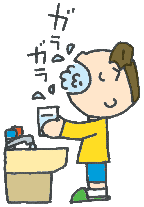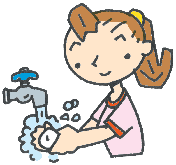


Common
Cold Syndrome
Common Cold Syndrome
is a general term of acute inflammatory disease of the upper respiratory
tracts such as nasal cavity, tonsils, pharynx
and larynx etc. Common Cold Syndrome includes rhinitis,
tonsilitis, pharyngitis, laryngitis (including croup), pharyngo-laryngitis
etc. So, the primarily belongs to the same disease group. Sometimes
Influenza (the flu) and sinusitis are characterized as a common
cold syndrome. For example, you may have a different explanation
about your disease in a different department (of the clinic) such
as internal medicine, pediatrics and otolaryngology
etc., then there are different therapeutic procedure and treatment
period for each.
Subjective Symptoms
Subjective symptoms are variously related with
the region of upper respiratory tracts such as snivel,
nasal obstruction, sneezing, sore throat
(pain, thirst feeling and hoarseness), cough, sputa,
headache, fever, general malaise (laziness),
muscle pains, arthralgia (joints pain) etc.
Digestive troubles such as nausea, vomiting, diarrhea
and abdominal pain etc are often recognized with various
subjective symptoms mentioned above. In influenza infection
(flu), these subjective symptoms are seen acutely and strongly.
When the inflammation foci have spread to the lower respiratory
tracts such as trachea, bronchi and lung, moist cough, viscous
and colored sputa (yellowish - greenish), and stridor etc will
arise. Then, we have to consider bronchitis and pneumonia. The
proverb says, "A cold may develop into all kinds of illnesses.",
so you have to pay attention to change of your subjective symptoms
when you have had a cold.
Generally, the patients
with common cold syndrome will get better within a week. Please
notice that the symptoms of asthmatoid bronchitis or allergic
bronchitis (continuous cough without dyspnea) and the primary
symptoms of Hepatitis-A are similar to those of common cold syndrome,
so you should consult your doctor if you are anxious about your
disorders.



Cause
Change of temperature (coldness)
and non-infectious factors such as allergy can be a cause of common
cold syndrome, but main cause of common cold syndrome is viral
infection to the respiratory organs. They are Rhinovirus,
RS virus, Influenza virus, Corona virus,
Adenovirus, ECHO virus and Coxsackie virus
etc. The virus source to the digestive disorders are SRSV
(Small Round Shape Virus) and Rotavirus which is usually
seen in infants. Among adults, Rhinovirus is commonly seen, and
RS virus, Parainfluenza virus and Corona virus are common viruses
among children. Influenza infection (acute and severe symptoms
are characteristic), Rhino virus infection (rhinitis like), RS
virus infection (also rhinitis like) and Parainfluenza virus infection
are commonly prevalent in winter and spring. Adenovirus infection,
Enterovirus infection, Coxsackie virus infection and ECHO virus
infection are commonly seen in summer (it is called hot weather
cold). Every virus has an affinity with the infection region
of the respiratory organs to some degree, but it is difficult
to identify the caused virus only by clinical symptoms, and it
needs to segregate each virus by genetic diagnosis procedure such
as PCR or by immuno-serological examination etc using nasal
secretion or tissue from throat and serum in order to identify
the virus exactly. However, it is not significant
to identify the caused virus except Influenza virus and Adenovirus
in daily medical work. Please ask details to your doctor.
On the other hand, Group-A hemolytic streptococcus infection
is important in the cases of bacterial tonsilitis and pharyngo-laryngitis.
This infection can be diagnosed by quick test using agglutination,
white blood cells counting and CRP test. We can do this quick
test at our clinic. Other caused bacteriae are staphylococcus
and Haemophilus influenzae. Anti-biotics is effective to bacterial
infection.
Treatment
To keep room warm and humid, taking rest, enough rehydratiion
and taking nourishing food are the principle of treatment for
common cold syndrome. And please have plenty of sleep and do not
overwork yourself. Especially, the elderly or anyone with complications
such as cardiac diseases and diabetes etc should have more adequate
rest. We usually carry out the symptomatic therapy for the present
symptoms. Most of the cases of common cold syndrome by viral infection
except influenza will improve within a week. Antibiotics should
be used in the case of aged person, a case with complication,
a case with immunodeficiency and a case of infant, because a bacterial
infection can easily complicate these cases. If clinical symptoms
have not been improved for more than a week and if the complication
by bacterial infection is strongly suspected because , blood test
such as white blood cell counting, CRP test, liver function test
(GOT and GPT etc), and Chest X-ray examination should be
considered.
When flu (Influenza virus infection) is suspected,
a quick test should be considered, and an anti-influenza virus
drug (neuraminidase inhibitor : Brand name Tamiflu 75) should
be prescribed at once (within 48 hours recommended) in a case
with positive diagnosis from the quick examination. You can undergo
this quick examination for Influenza virus infection (both type
A and B) at our clinic. Influenza virus of both type A
and B can be detected using nasal secretion within 15 minutes.
As for medication, acetaminophen should be used as an antipyretics
for cases of Influenza infection, because other antipyretics have
a possibility of inducing Rye syndrome. Also, a non-steroidal
anti-inflammatory drug has a possibility to induce fatal attack
to 6-7 % of the patient under treatment of asthma bronchiale.
It is called aspirine-induced-asthma. The important matter is
that you should consult a doctor, and please have proper treatment
with pertinent examinations.
Gargle and hand-washing are the most
effective method to prevent common cold syndrome due to viral
infection including serious influenza infection.


Exacerbation of common
cold and advance to lower respiratory tracts
In cases with persistent symptoms or cases
where symptoms have been deteriorating, inflammation may have
advanced to the lower respiratory tracts (bronchus and lung).
Severe cases of the common cold often complicates bronchitis,
bronchiolitis and pneumonia.
1.
Acute Bronchitis
Acute bronchitis is an inflammatory
disease of bronchus, and it occurs in succession of acute upper
respiratory tracts infection namely common cold syndrome. The
symptoms are fever, cough, sputa (yellowish or greenish viscous
sputa) and stridor etc. Moist rales can be audible on the chest
by suscultation. Usually, there is no infiltrative shadow (consolidation)
in Chest X-ray film in a case of bronchitis. But sometimes we
can detect the thickning of bronchus wall in chest X-ray film,
and it is called "bronchial cuff" by medical term and
this is the only finding of X-ray film in case of bronchitis (without
pneumonia).
More than 90% of its cause is viral
infection such as Influenza, Parainfluenza, Adenovirus and RS
virus etc. But bacterial infections such as pneumococcus and Haemophilis
influenzae are also recognized. In cases with severe cough, Mycoplasma
and Chlamydia are often detected, and they can be a cause of pneumonia.
Symptomatic therapy is the main treatment for
cases of viral infection, the same as cases of upper respiratory
tracts infection. According to the symptoms, additional medicine
such as antitussives, expectorants, bronchodilator and antipyretics
etc are used. You should consult a doctor of internal medicine
earlier.
In a case of bronchiolitis, antibiotics
is prescribed.
To keep room warm and humid, taking
rest, enough rehydratiion and taking nourishing food are necessary
same as common cold syndrome.
2.Asthmatoid bronchitis(allergic bronchitis):CVA(Cough Variant
Asthma)
Primarily, asthmatoid bronchitis is
a bronchitis with stridor, and it is seen in infants and babies.
In adults, it is called allergic bronchitis. They are not the
disease name but mean pathologic state. They include bronchitis,
bronchiolitis, retention of secretion in trachea, and asthma with
infection.
The cause is almost same as acute bronchitis,
and treatment is also same as acute bronchitis basically.
3.Pneumonia
Pneumonia treated at the
out-patient clinic is called city pneumonia and it is differntiated
from nosocomial infection pneumonia occurred in the hospital.
Bacterial pneumoniae caused by pneumococcus and Haemophilis in
fluenzae infection should be distinguished from primary atypical
pneumoniae caused by mycoplasma and chlamydia infection. In treatment
of bacterial pneumoniae, the possibility of penicillin-resistant
Streptococcus pneumoniae (PRSP) should be considered in the cases
of more than 65 years old, presence of alcohol dependence, presence
of immunodeficiency, complications and history about medication
of β-lactam antibiotics within the past 3 months.
Common Cold Syndrome in Children
Common cold syndrome is the disease of high frequency
in children in daily medical work, and most of its cause is viral
infection. Major symptoms are fever, snivel, cough, appetite loss
and dullness etc, and primarily they are almost same as thoes
in adults. A mother sometimes does not notice her baby's fever-up
until she takes her baby to the clinic by the symptom of bad-temper.
Children have many opportunities to be infected in day nursery,
kindergarten and school in prevalent season.
Infants
and babies will easily be led into dehydration and become exhausted
when they have digestive troubles as vomiting and diarrhea with
high fever. Therefore oral rehydration and attention to meals
are necessary according to the age of the patient. Making a record
about fever and its pattern, about volume and frequency of taking
water, and about frequency of urination will give useful information
for diagnosis and treatment. In a case with severe dehydration
due to high fever, vomiting and diarrhea, when the patient cannot
take water and food orally, drip infusion therapy is indispensable.
Download
PDF file of Common Cold Syndrome ![]()
To top of this page